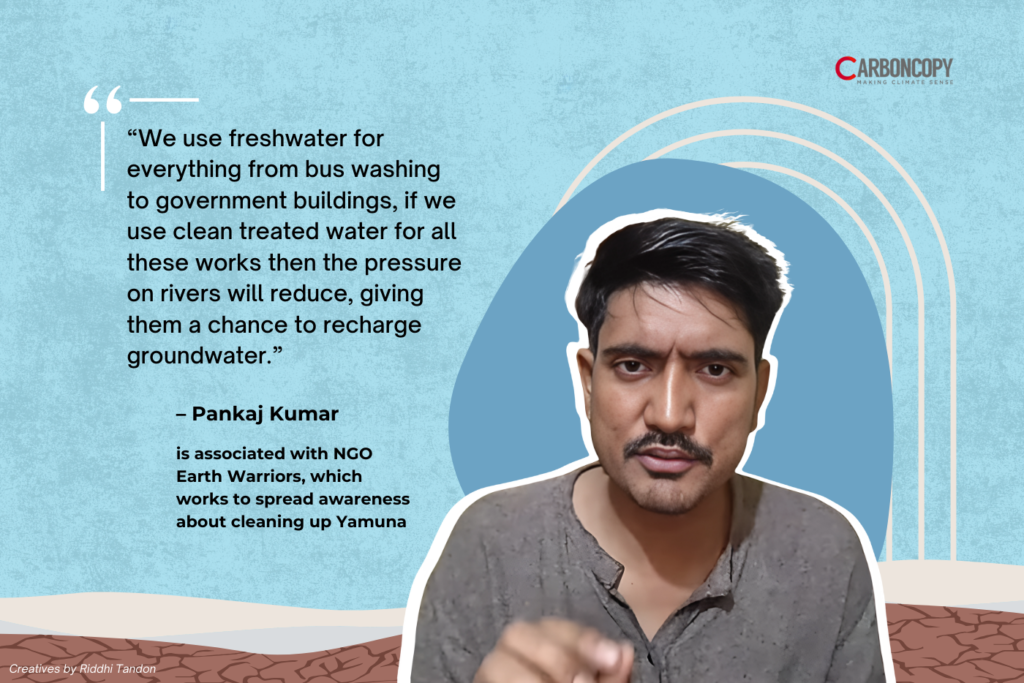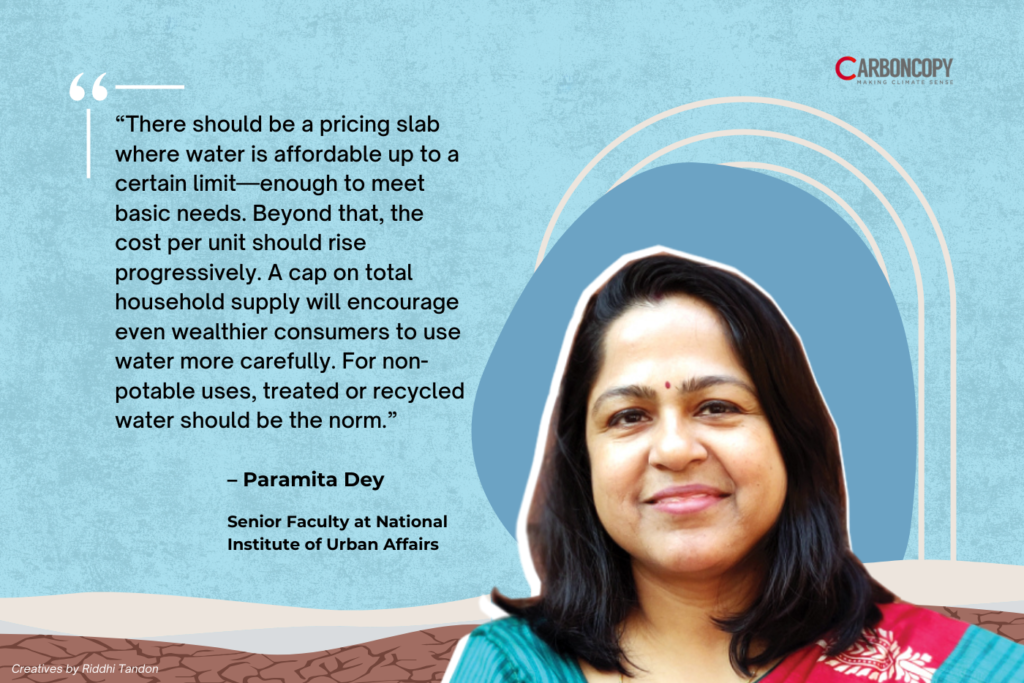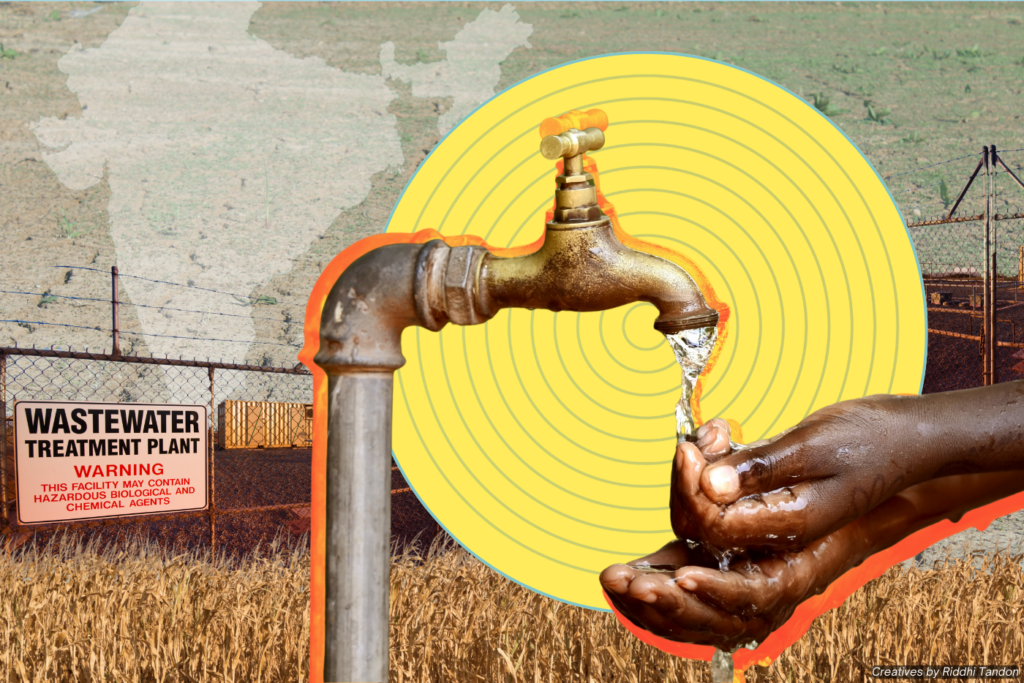As taps run dry, experts push for reuse, recharge, and a radical rethink of how cities manage water
India ranks among the most water-stressed countries. According to the 2023 Aqueduct Water Risk Atlas released by the World Resources Institute (WRI), India stands 24th out of 25 nations facing “extremely high” water stress. According to the report, this means the country is using at least 80% of its available supply.
Rapid urbanisation is worsening the crisis. Between 2013 and 2023, India’s urban population grew from 32% to 36.36%. In 2024, metro cities—home to over 11.73 crore people—accounted for more than 8% of the national population.
Pressure on water resources is mounting at multiple levels. India recently suspended the Indus Waters Treaty with Pakistan, a landmark agreement signed in 1960 to govern the sharing of river waters. The move comes amid broader tensions, following a terror attack in Kashmir, which took the lives of 26 people, including tourists. It reflects how water scarcity is no longer just a domestic governance challenge, but an increasingly strategic and geopolitical concern.
At home, Indian cities and towns are growing at an unsustainable pace, their water sources are running dry. From shrinking rivers and rapidly falling groundwater to unequal access and rising pollution, the urban water crisis is deepening. Poor planning, unchecked construction, climate impacts, and outdated infrastructure are all making matters worse. Experts say the way forward lies in smarter use of local resources and treating wastewater as a valuable asset. Can India’s cities act in time to secure their water future?
Groundwater realities
A 2018 report by India’s apex think-tank and Niti Aayog predicted that 21 Indian cities — including Delhi, Bangalore, Hyderabad and Chennai — will run out of ground water by 2020. While that hasn’t happened yet, the crisis looms large.
The cities are extracting water at unsustainable rates,” says Dipankar Saha, former member of Central Ground Water Board (CGWB) and currently Chair Professor with Manav Rachna International Institute of Research and Studies (MRIIRS).
Saha explains that almost 70% of India’s geography is hard rock which has low permeability, therefore the water is not easy to recharge.
He says, “In hard rock areas, there is less potential to recharge the source, the groundwater level is falling rapidly but the rate of extraction remains the same or going up.” Saha gives an example of Faridabad city, which is adjacent to Delhi and running out of groundwater. “Even though the city is at the banks of river Yamuna, the dependence is entirely on groundwater. Since there is no recharge commensurate with the heavy rate of extraction the water table has fallen sharply.,” he adds.
Day zero cities and dying rivers
In 2019, Chennai nearly ran dry. Officials had to declare a “Day Zero” situation in the city when its four main reservoirs almost ran out of water. Queues, chaos, and emergency water tankers ensued. Researchers attributed the problem to poor planning and destruction of water bodies in India’s sixth-largest city with an estimated population of more than 10 million.
But Chennai is just one example. The World Wide Fund for Nature (WWF) listed 100 cities who will face ‘grave water risk’ in 2050. Among them there were 30 Indian cities, including Delhi, Mumbai, Kolkata, Bengaluru, Lucknow and Bhopal. This would be driven by a dramatic rise in the population percentage from 17% in 2020 to 51% in 2050, the report states.
Even hill stations aren’t spared. In 2018, Shimla’s taps ran dry leading to protests by the local population. “In the past two decades, snowfall has reduced. Earlier, we had several feet high snow in these hills between December and March. Now it is hardly a foot high and that too for a few days in the whole year. We have dry winters and less rainfall. There are other problems as well such as unregulated construction and poor waste management, which has killed the aquifers,” says Sanjay Chauhan, a businessman and former mayor of Shimla municipal corporation.
Shimla requires around 45 million litres water per day (MLD) during peak tourist season. But it hardly gets around 30 MLD per day. The story is similar in other hill stations as well such as Nainital, Mussoorie, Kullu, Ooty and Kodaikanal.
“Cities like Chennai, Shimla, and Nainital are warning signs of what uncontrolled demand and environmental carelessness might do. For instance, increased built-up areas and widespread concretisation—along with the filling of ponds and construction that ignores natural water channels—have contributed to more frequent and severe urban flooding,” says Paramita Dey, senior faculty at National Institute of Urban Affairs, New Delhi.
Vanishing rivers, uneven rain
Across India, rivers, too, are vanishing outside monsoon windows. An analysis by the Central Water Commission (CWC) last year found there was “no water left in the rivers between Mahanadi and Pennar basins that flow through Andhra Pradesh, Telangana and Odisha.”
“As a result of climate change, a lot of rain falls in a very short span of time. This means the number of rainy days are less. If you check the data of the past few years, you will find the same big cities, be it Chennai, Delhi, Hyderabad, Lucknow or any other city, are facing droughts and floods in the same year,” says Sushmita Sengupta, Senior Programme Manager of Water Programme with the Center for Science and Environment (CSE).

The Ganga basin is another example. It has seen the lowest snow persistence in 23 years, threatening cities downstream. This water shortage in the river basins gravely affects the socio-economic conditions, livelihoods and agricultural activity of the regions dependent on the rivers. Not to mention the health of the rivers.
“A river’s health depends largely on how quickly rainwater flows into it from its catchment area. The slower the flow, the better the river’s condition; rapid runoff, on the other hand, leads to poor river health. Forests, wetlands, local water bodies, and carbon-rich agricultural fields help absorb and gradually release rainwater, supporting year-round river flow and protecting against both floods and droughts,” says Himanshu Thakkar, Coordinator of South Asia Network on Dams, Rivers and People (SANDRP).
Unequal and unreliable access
This widening gap is not just about scarcity—it’s also about inequality. India’s per capita water availability, according to government data, is declining—from 1,816 cubic metres in 2001 to a projected 1,367 cubic metres by 2031. Urban benchmarks by the government set supply at 135 litres per person daily, but access varies wildly. While some city dwellers enjoy 24/7 piped supply, others—especially in slums—live with chronic shortages. Big cities also often draw water from far-off regions, depriving locals.
This writer documented the water problem in Rajasthan where people ran “No Water, No Vote” campaign during assembly polls in 2018.
Thakkar says there’s no real policy for urban water management. Instead of optimally using local sources like rainwater, ponds, or rivers, cities rely on long-distance transfers, according to him. “We have smart city projects, but there is no definition of a water-smart city. The city should be able to manage and use its local water resources optimally.”
Thakkar recalled that during his time on the working group for the 12th Five Year Plan (2012–17), it was recommended that cities should only be allowed to draw water from external sources if they could first demonstrate optimal use of all local water resources.
Pollution: The other crisis
Even if water is available, it is often unsafe. Despite India having 4% of the world’s total freshwater resources, its quality is very poor. The country ranked 122 out of 124 countries on the World Water Quality Index in 2024. The Niti Aayog report also acknowledges the poor quality of water across India.
Industrial effluents, untreated sewage, and poor waste disposal have left shallow aquifers toxic and rivers choking with contaminants like cadmium, lead, and arsenic.
“The major issue in urban areas is that there are many legal and illegal industrial units running. Besides polluting rivers these industrial units are discharging hazardous chemicals, which percolate into the ground. Even the treatment technology is not up to the mark. It can not treat heavy metals like cadmium, chromium and mercury properly,” Saha told Carboncopy.
“Deep aquifers are still relatively safe, but shallow aquifers are totally contaminated. Some of the contamination like arsenic occurs naturally, but human activities are worsening the problem ” he said.
In response to a question in the Rajya Sabha, the government has admitted to “the occurrence of contaminants such as fluoride, arsenic, nitrate and heavy metals, beyond permissible limits (as per BIS) for human consumption in certain isolated pockets in some States / UTs.”
Despite spending over ₹33,000 crore in four decades, the Ganga remains polluted. A CWC study found 81 Indian rivers and tributaries with dangerously high levels of toxic heavy metals. According to the report, the heavy metals detected beyond safe limits included arsenic, cadmium, chromium, copper, iron, lead, mercury and nickel.
One of the biggest reasons rivers stay polluted is the unchecked dumping of untreated sewage, experts say. Cities along riverbanks routinely release waste directly into the water, and across states, this has become business as usual. Just this month, the National Green Tribunal (NGT) pulled up the governments of Jharkhand and Uttarakhand for allowing untreated sewage to flow into the Ganga.
While river pollution remains a serious concern, government data suggests some progress. According to the Central Pollution Control Board (CPCB), the number of polluted river stretches has dropped from 351 in 2018 to 311 in 2022. Of the 180 stretches out of the 351 flagged as polluted in 2018, water quality improved in all—106 were removed from the polluted list entirely, while 74 were downgraded to a lower-risk category. In 2015, 70% of monitored rivers (275 out of 390) were classified as polluted. By 2022, that figure had dropped to 46% (279 out of 603), according to government assessments.


The way forward
Experts advocate a shift in thinking. Wastewater isn’t a liability, but a resource. A comprehensive water conservation and management policy is the need of the hour. Shifting the thinking from a supply-driven approach to an integrated urban water management system should be key, say experts.
“We have been doing piecemeal planning in many cases. It is a well-established fact that the infrastructure for water supply is capital-intensive. However, we have not focussed adequately on operation and maintenance. User charges are not enough to recover Operation and Maintenance costs. Secondly, we have not been successful in reducing non-revenue water. A lot of water is lost in leakages,” says Dey.
“Decentralised treatment, strong regulatory control, and public confidence-building will help India realise the possibilities of wastewater reuse,” she said.
Cities like Singapore and El Paso, Texas, treat and reuse wastewater to meet up to 40% of their water needs. India has the potential to follow suit—if treatment plants work efficiently and sludge is managed.
But India is able to recycle only a fraction of its wastewater. Over 72,000 MLD of wastewater is generated daily in India, but only 28% is treated. In Delhi, over 1,000 MLD of sewage flows into the Yamuna untreated, despite having 37 STPs—half of which do not meet the standards set by CPCB.
“We use freshwater for everything from bus washing to government buildings,” says environment activist Pankaj Kumar, who is associated with an NGO Earth Warriors, which works to spread awareness about cleaning up the Yamuna. “If we use clean treated water for all these works then the pressure on rivers will reduce, giving them a chance to recharge groundwater,” Kumar said.

Kumar gives the example of Pappan Kalan in Delhi and some areas in Noida where STPs are working well and the water is being used in agriculture and for groundwater recharge by making ponds.
According to a CEEW report, treated wastewater in India could irrigate 26 times Delhi’s area by 2050. The market value of the treated water will be ₹1.9 billion in 2050. Another report by CEEW last year highlights Haryana, Karnataka, and Punjab are the frontrunners of used water management in India.
Nitin Bassi, Senior Programme Lead with CEEW, said, “Many Indian cities are now water-stressed. For instance, Bengaluru, which draws most of its freshwater from the Kaveri River and borewells, is currently facing a severe water crisis. Reusing used water to its full potential for non-potable purposes will be key in the future.”
Pricing for sustainability
One way to make people responsible and conserve water is to put a price on it. Although people purchase bottled water for drinking, it is largely free in homes. “Free water leads to waste,” says Saha. “If there is a price, it will enhance the water use efficiency,” he said.
Many experts agree with this idea. Globally, a debate on incremental pricing of water is going on and many countries have implemented the idea where consumers pay for water beyond a certain limit and the price increases with the increase of consumption.
“There should be a pricing slab where water is affordable up to a certain limit—enough to meet basic needs. Beyond that, the cost per unit should rise progressively. A cap on total household supply will encourage even wealthier consumers to use water more carefully. For non-potable uses, treated or recycled water should be the norm,” Dey said.

India’s urban water crisis is no longer a looming concern—it is a daily reality for millions. Rivers are shrinking, groundwater is vanishing, and the divide between those with access to clean water and those without is growing starker.
But the solutions are within reach. Cities must shift from extraction to conservation, from treating wastewater as waste to recognising it as a resource. Equally critical is rethinking how we value water—through pricing, equitable access, and better infrastructure management.
The urgency is clear. The question now is—will India’s cities rise to the challenge—or wait until it’s too late?

